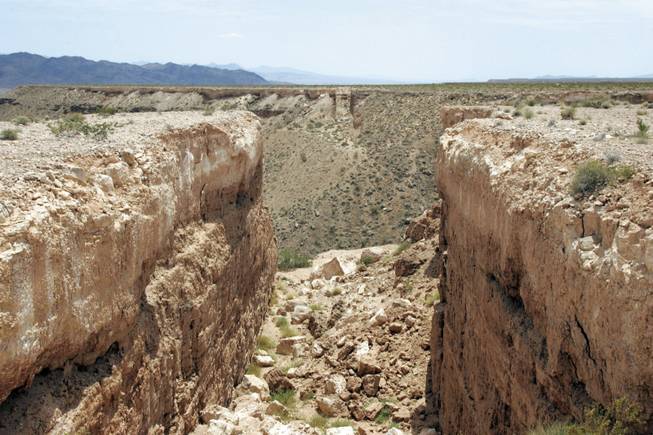
This is the view looking south at “Double Negative,” Michael Heizer’s first prominent earthwork. “Double Negative” consists of two trenches cut into the eastern edge of the Mormon Mesa northwest of Overton. Many residents don’t know it’s there, and the Moapa Valley Chamber of Commerce does not mention its existence on its Web site.
Thursday, June 5, 2008 | 2 a.m.
The truck rattles along the narrow, bumpy desert path that ribbons up Mormon Mesa and across a vast plane of brushy desert.
Suddenly there is an abrupt canyon, a slice in the ground, a craggy edge atop erect walls, a void in an otherwise hard desert floor, a “gouge.”
Hiding in plain sight some 80 miles northeast of Las Vegas, Michael Heizer’s “Double Negative” is one of the largest sculptures in the world. It’s 1,500 feet long, 30 feet wide and 50 feet deep.
About 240,000 tons of rhyolite and sandstone were blasted and scooped away in 1969 and 1970 to create the negative sculpture now owned by the Museum of Contemporary Art in Los Angeles. Its two trenches connect with a center canyon, creating a space that is “doubly negative.”
Pilgrimages are made to the site. Travelers from all over the world stop to contemplate space and displacement. It’s legendary. It’s historic, and to some, a little esoteric.
Realizing that we’ve both been in town for years and never seen it, photographer Sam Morris and I decide to take a drive.
Why not? Overton is lovely this time of year. A quiet town with deep agricultural roots and a rich archaeological history, it’s loaded with trees, crops, livestock, small businesses and local restaurants. And in its back yard sits a wedge in the ground that has garnered international fame since its “installation” and is the spark of many academic, philosophical and late-night informal conversations. It is one of the more significant works of the earthwork movement that included such artists as Robert Smithson, Richard Long and Dennis Oppenheim.
Photos can’t really explain “Double Negative.”
Art critic Dave Hickey can: “It’s a sophisticated and intellectual idea based on the idea that in the West, positive and negative space is reversed. Instead of extending the earth up, he extended the sky down.
“It’s what I consider to be the best solution for outdoor sculpture in the West because you can’t beat the sky.”
We aren’t sure what to expect of the work commissioned by New York gallery owner Virginia Dwan.
It seems like space interrupted. I expect a more visceral reaction. But these two wedges facing each other, crossing a canyon over a natural curve on the mesa, have me focusing on the land, rather than the void. What I really want is a giant timber to fit snugly into the chasms and actualize the line.
After an hour of thinking and not thinking, looking down, looking up, over, around and through, we read entries made in the log book of a nearby cache that was left by “geocachers” who play hide and seek with GPS devices. (“Very cool. Don’t get it though,” reads one of several entries left by geocachers, artists, students and architects.) We discuss conceptual art, which Heizer has said “Double Negative” is not.
Then we wonder, “What do the locals think?”
What happens next feels like a road trip with Christopher Guest.
Scene 1: Sugar’s Home Plate
“I hear it’s just a big gouge in the ground,” says a diner at Sugar’s Home Plate, where sports memorabilia cover the walls and ceilings. It’s lunchtime. Pretty waitresses serve hamburgers, the cook looks busy, and nobody is watching the French Open on the TV behind the bar.
Our waitress has never heard of “Double Negative,” nor has her co-worker.
The diner suggests we check the Lost City Museum, which is an archaeological tribute and study of the household items left behind by Anasazi Indians almost 2,000 years ago.
Director Kathryne Olson hands us a printout of directions to “Double Negative” that are kept at the front desk.
“We get people from all over the world who come and see it,” Olson says. “A lot of people from France.”
This makes sense, given that in the summer, the Germans are busy navigating their way through Death Valley on 120-degree days.
“Locals don’t know much about it, though,” Olson says. She adds that local real estate broker Bryant Robison cleared the site for Heizer.
Scene 2: “Double Negative Days”
There are no signs, markers, postcards, books or T-shirts referencing “Double Negative.” There’s not even a mention on the Moapa Valley Chamber of Commerce Web site.
“It probably ought to be done,” says Vernon Robison, Chamber of Commerce president and managing editor of the Moapa Valley Progress.
Robison is fond of the sculpture. He says the Chamber of Commerce is occasionally asked about the work by out-of-towners. Local opinions vary.
“A lot of people who have heard about it haven’t been out there and wouldn’t know where to go. A good number of the population would look at it and say, ‘It’s just a huge trench in the ground,’ ” he says. There isn’t really enough appreciation in town to create “Double Negative Days” or anything like that.
We laugh.
Overton, Logandale and Moapa make up Moapa Valley. Judging from the number of post office boxes, Robison guesses there are 10,000 residents.
The 4-H club thrives. Trucks with horse trailers park outside of brick houses. An irrigation system runs through town. A sign along Moapa Valley Road reads “Welcome Home Elder Samson.”
More than 80,000 visitors attend the Clark County Fair in Logandale each year. About 12,000 attended last fall’s Moapa Valley Pomegranate Art Festival.
Scene 3: A castle by the road
Sam sees a castle and turns off the road. We stare at the home with turrets, a saw-toothed roof, an 8-foot door, a drawbridge and a sign that reads “Mortensen Castle” before realizing the woman in the driveway is talking to us.
“Do you have any questions?” she asks. “I offer tours all the time. We get people from all over who stop in. Would you like to see it?”
Connie Mortensen is wonderfully chatty as she takes us past the Princess Tower Bedroom, up the spiral staircase and onto the flat roof that overlooks the area. We smile at her family members.
She wanted a log cabin; her husband wanted a castle. This is their compromise.
Mortensen has only heard of “Double Negative.” “I remember someone telling me about it,” she says, “a Realtor, Bryant Robison.”
Scene 4: The earthmover
Robison answers the door in coveralls, steps onto the small concrete steps and closes the door behind him so we don’t interrupt the piano lesson inside.
Finally, the man.
We ask about “Double Negative.” He pauses, shakes his head a little and smiles. “That was a long time ago.”
In the back yard, he pulls up a couple of chairs.
“One day a couple of hippies drove in town in an old beat-up Winnebago motor home. They said they wanted to do an art piece, an earth sculpture, and took out a pencil and did a sketch. I thought they were crazy.
“He chose that particular area because he liked the contour of the land.”
Robison agreed to do the job but wanted to be paid upfront.
“They drove off and I figure so much for that because I asked for the $10,000. Ten days later, a cashier’s check came from New York City.”
With a couple of guys helping, Robison drilled, dynamited and dug the trenches.
“It was the talk of the town,” Robison says. “People come from far and wide to see it. There was a story in Esquire and in Life. Interesting people came by. We enjoyed it. As far as I was concerned, it was a big earth-moving job.”
Heizer was there at the beginning. He stopped by a couple of times during the project and again at its completion.
Robison befriended the reclusive Heizer. They last spoke a year ago.
The artist is now 30-some years into “City,” a mile-long work in a location (remote though visible on Google satellite) in Nevada northwest of Cedar City, Utah.
Scene 5: Local artists
“Double Negative” is still clearly defined, though erosion has begun. It’s no longer crisp. Sand and boulders have fallen into the wedges.
The Museum of Contemporary Art is not conserving “Double Negative” in accordance with an agreement with the artist, who said he wants nature to “reclaim the land.” Museum staff travel to the site informally and have no official contact in Overton.
There is no word as to whether Heizer has come around over the years.
Born to a archaeologist father, he isn’t completely separate from the Overton culture. Like the ranchers and gardeners, he merely wanted to work with the earth.
Still, his concept seems a tad esoteric, or just plain silly, to some.
“You were out here looking at what?” says Flo Lund, president of the Moapa Valley Art Guild. “I have no idea what that is.”
To be fair, Lund, almost 70, has been living in the area 11 years and has been a musician all of her life. She joined the art guild eight years ago, hoping to bridge the gap between music and visual art. She paints landscapes but is still “finding her voice,” and leads a choir and recorder quintet that plays Renaissance music.
Max Bunnell knows a little more. He started the guild 50 years ago and took his high school art students to the site shortly after it was created:
“Some thought it was a waste of money. Some thought it was a nice piece of art. I think it’s a nice piece of art, but a lot of people don’t get too excited about that kind of stuff. It would have to be something that they could relate to closely.”
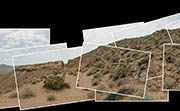
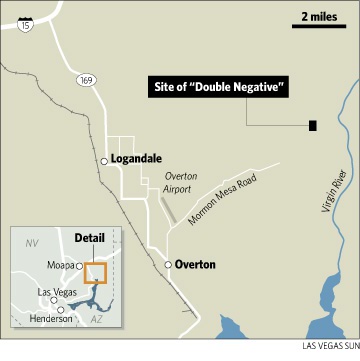
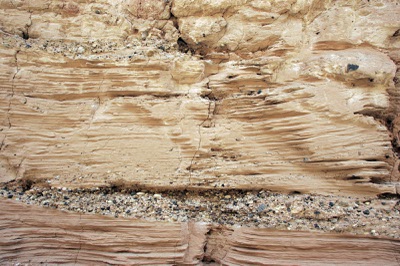
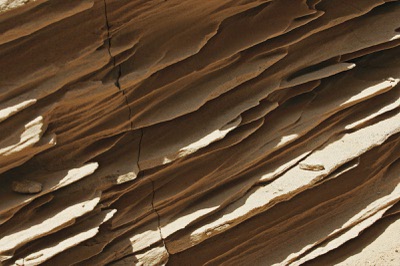

Join the Discussion:
Check this out for a full explanation of our conversion to the LiveFyre commenting system and instructions on how to sign up for an account.
Full comments policy